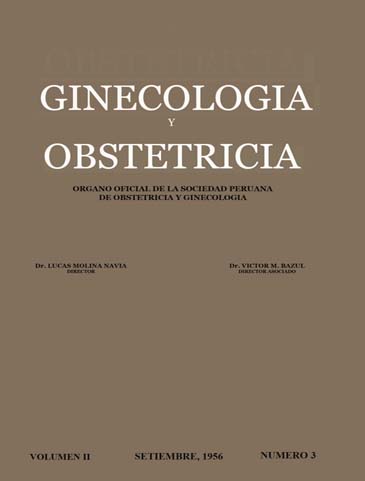Genital Endometriosis. Considerations about 465 comments
DOI:
https://doi.org/10.31403/rpgo.v2i1120Abstract
A review is made of 465 cases of endometriosis pertaining to the gynecology Clinic of Buenos Aires from the year of 1928 to 1955. Theses 465 cases are 1.6% of the total number of gynecological patients. 90.3% of these material is constituted by non associated endometriosis. These cases have been classified into varios groups: Mucous endometriosis 62% (internal uterine and tubal endometriosis). Serosa endometriosis (ovary and peritoneal): 27.4%, Others, 10.6%. The internal uterine endometriosis constitutes the most important group, 47.5% of 911 the material. The author is able to recognize it macroscopically. It can be circumscribed or difuse. It is posible to confuse them, by macroscopically examination, with difuse hyperplasia and uterine myomas. In 51 of the cases there was a reaction to the hormone stimulation. In 18 of the cases there was hyperplasia of different degree. The greatest number of cases of the normal diphasic cycle has internal uterine endometriosis. There are two cases of endometriosis and pregnancy. There is one case where the patient had of perforation at the level of a focus of an internal endometriosis, during the curetting after an abortion. In 4 cases the malignancy transformation was observed and in 3 of them coexisted with A. C. E., and in the fourth case it was exclusive. A case where sarcomatous degeneration was observed. The following are frecuently associated with the internal uterine endometriosis: Myomas, 55%, Hyperplasia of the Endometrium, 14% Adenomas, 14.4%. Salpingitis, 9%, Ovarían tumors, 5,4%. Cancer of the cervix, 3,1 %, Cancer of the endometrium, 2.7%. An isolated internal uterine endometriosis is not frequent. The symptoms most frecuently found are: Low abdominal pain, 70%, metrorragia in 16,6%. The author suggests and explanation of the hemorrhage. The diagnosis is presumed in the majority of the cases. The X-Ray very poor information. The pharmacodynamic tests are of relative value. The treatment is conservative surgical, unless other associations might requiere other more ample procedures. In the endometriosis of the ovary the characteristic fact is the "chocolated cyst", and it could be attached to the adjoinning structures. Histologically easily recognized when they are small, not so when they are very large and old. There is less conjuctive tissue around of heterotopic endometrium. Only in 43% of cases pure forms has been found. Others associations: Uterine myoma, 4 cases. Ovarian tumors, 6 cases. Adenomas, 5. Salpingitis, 7 cases. Hyperplasia of the endometrium, 4. Cancer of uterine cervix, 3. The important complaints are: Pain, 25% of cases during menstruation. History of a painful crisis accompanied by a peritoneal irritation. Moderate increase of temperature, 8,9%. The symptoms of compression of the adjoing visceras have been observed with less frecuency. Sterility in 8,7% of cases. The diagnosis is difficult, the process must be kept in mind. The treatment is surgical and as far as possible conservative. There are 50 pure cases of tubal endometriosis. Interstitial forms, 58%. Isthmic, 14%. Ampullar: 16%, and 12% localized in the ampulla and interstitial portions. In both tubes, 66%. May be associated with uterine myomas, ectopic pregnancy, cancer of cervix, tumors of the ovary, etc. By the diagnosis of microscopic examination is required, because may be confused with ectopic pregnancy, endosalpingitis. The tubal endometriosis is frecuent in woman under 40 years of age, while the uterine endometriosis is frecuently after the four decade of the life. Sterility, 62 % of cases. Those localized in the interstitial portion are asyntomatic. Dismenorrhea, 4 cases. The ampullar form gives a painful sintomatology. The closer they are to the abdominal ostium, more painful they become. Conservative treatment if it is possible. There was 31 cases of peritoneal endometriosis, localized specially in the Douglas. Symptoms: Constant intermenstrual dismenorrhea with is intense, progressive. Hypermenorrhea. Urinary syntomatology. The treatment is partial resection or in relation with the present conditions. The author describes 13 cases of perforating fornical vaginal endometriosis. This variety together with vesical and umbilical endometriosis are accesible and easily diagnosticated. In 6 cases was possible establish the relationship with the ovary endometriosis. In all of them there was an invasion of the rectovaginal septum. Occurring most frecuently between thirty and forty year of age. As for the syntomatology, this is not unlike that of chronic pelvic inflamatory disease, except that in many cases severe dysmenorrhea is present and that is frecuently referred to the rectum or sacrococcygeal region. The treatment as far as possible will be conservative.Downloads
Download data is not yet available.
Downloads
Published
2015-06-29
How to Cite
Ahumada, J., Sardi, J., & Arrighi, L. (2015). Genital Endometriosis. Considerations about 465 comments. The Peruvian Journal of Gynecology and Obstetrics, 2(3), 241–262. https://doi.org/10.31403/rpgo.v2i1120
Issue
Section
Artículos Originales
















